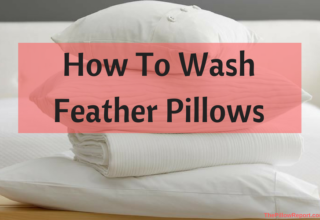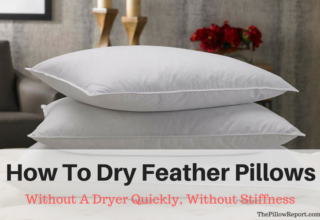Resuscitate begrimed items by equipping yourself with a good command of how to clean old feather pillows. Some antiquated feather pillows still possess the buttery-soft, fluffy headrest to curl up with for a cozy and dead-to-the-world slumber.

Natural filling force you to dig deeper into your pocket to get your fingers on super-plush, breathable and comfortable support. Old feather pillows contain a musty scent or become soiled with typical usage.
Things To Consider | How To Clean Old Feather Pillows
1. Inspect Pillows from Stem-to-Stern
Before taking the first step, inspect the state of the outer shell and fillings inside for lumps or spent fluffiness. You have three options, viz. spruce them up, replenish fillings or replace everything.
If the ticking cover has a tightly woven seam, but feathers poke through, renew the casing or stitch openings before you wash them.
Pre-fill patched pillows with feathers from other down/feather sources like old comforters. Some folks improvise this with a dense foam core at the center of the feather pillow.
For yellowed and trampled pillows whose filling has degraded into an amorphous yucky mess, you’ll have to reconstruct everything, new cambric cover and feathers/down.
2. Washing Feather and Ticking Simultaneously
If you have feathers and ticking in good shape with no yellow or red tarnishes, spruce up everything together.
- Wash in machine or hand-wash in warm but not hot suds for 15 to 20 minutes. Add all-natural soap and boost with a disinfectant while observing product directions.
- When using an automatic unit, wash at least two pillows to balance the load. Set it on the delicate or gentle cycle. A full wash-cycle can smash the quills or irreversibly mat the fillings.
- For hand-washing, rinse at least thrice in pristine warm water. Spin-off liquid or squelch out as much water as you can but do not wring.
3. Automatic Dryer At Moderate Heat Settings
Put the pillows in a dryer and adjust the settings on the moderate or low heat settings.
Add two tennis balls or several bath towels with your bedding to speed up moisture evaporation and fluff up feathers as they dry out.
Operate the dryer two to three times, or until your pillows become as dry as dust.
Pull out the pillows in between cycles and fluff them with your hands for even distribution of filling within the shell.
You can also dry the padding in a warm room using a drying rack equipped with a fan or dangle on a clothesline clipping them at two ends. Shake and flip cushioning to fluff filling and speed up the drying process.
4. Washing Feathers & Ticking Separately
If ticking lacks the purity of driven snow, blemished with red and yellow mud, clean the outer shell and feathers separately.
- Use a lightweight bag with tightly woven fabric with space two to three times the size of the ticking.
- Open one side of the ticking and pin the unclosed edges of the shell and the bag jointly.
- Empty contents of the ticking into the pack by shaking gently. Stitch a seam in the pouch to lock it.
- Wash and dehumidify the bagful of feathers, adhering to manufacturer directions.
- Clean the ticking with a disinfectant in the initial wash and follow product instructions. Re-wash until stains whiten. Stubborn red or yellow stains require bleaching or treatment with a rust remover.
- You can dispatch pillows to a commercial renovating provider if you cannot DIY. The cost of a new casing for feathers and cleaning falls below the value of replacement.
- They will keep your feather fillings separately from other customers’ and render a bespoke cleanup such as sterilization.
- Specialized equipment allows renovators to restore and rejuvenate feather pillows.
- Multi-phased sterilization begins by bursting open the pillow ticking and emptying contents into a compartment. In these chambers, sterilization with ozone-emitting, UV light exterminates allergens, purifies and deodorizes filling. They also sift out dust emitted by disintegrated feathers.
- At the final stage, they blow the sanitized contents into a new ticking.
- You can reuse old pillows to create sprawling floor cushions
- You can repurpose pillows as pet beds for your furry companion to curl up with an elegant piece of luxury.
- You can reuse them as packing filler or for moving materials.
- Go DIY to fashion your throw-cushions at zero dollars.
- Seal up the front of external doors, or by drafty window sills and keeping your interior cooler or warmer.
- Create gardening cushions instead of spending for a new knee cushion.
- You can donate them for recycling or textile recycling facilities near you to cut back carbon emissions.
5. Handling Unclean Feather Pillows
The filling may contain harmful bacteria and toxins which may endure regular laundering with ordinary soaps. A spick and span cleaning combined with sterilization using a disinfectant kills microbial invaders.
Wear rubber gloves and protective gear when handling infected pillows such as flood-soiled bedding.
Do not dry ticking with a dryer before edging out all stains.
Before emptying clean feathers into the ticking, iron and starch it for a smooth slide.
Some pillows may have soaked in water or become contaminated with intoxicating muck that makes it impossible to purge all unpleasant odors.
Desist from wringing or twisting as you will end up crushing delicate quills and weaken their natural resilience.
6. Pillow Renovation Companies
7. Benefits of Rejuvenating Old Pillows
Instead of adding junk to the landfill, large-scale consumers such as green hotels and hospitals recycle pillows.
A rigorous cleaning and overhauling old filling into a new ticking spawns a neat-as-a-new-pin at a fraction of the price of replacing feather pillows.
Pillow renovation by specialized experts without water, steam or heat preserves the natural properties of quills and natural oils. Detergents eat away oils causing the filling to flatten out and lead to allergen outbreaks.
All natural soaps and machine washing make old pillows new and freshened. If filling stills bristles with resilience, insulation, and loft, replace ticking to make it as clean as a new pin.
8. Other Alternatives to Reuse & Recycle Old Feather Pillows
Final Verdict
You can go DIY if you have a firm grasp of how to clean old feather pillows or seek the expertise of local bedding’s renovation companies. Once you reinvigorate pillows, remember to add a barrier or cover to protect against stains, dust mites, and micron-sized allergens.
Old feather pillows become a diamond in the rough for DIY enthusiasts determined to salvage the pliable, velvet and natural insulation of natural filling.
















